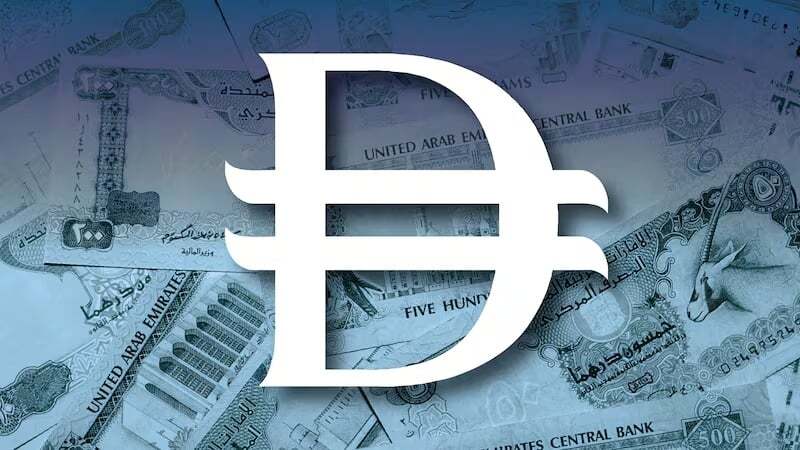UAE Unveils New Dirham Logo in Shift Toward Digital Economy
The UAE has unveiled a new logo for the dirham and digital dirham (CBDC), strengthening its monetary identity in global markets. Here’s what that means.

On March 27, the Central Bank of the UAE officially gave the dirham a logo of its own. Inspired by the UAE flag, the logo depicts the latin letter “D” with two horizontal lines through it, symbolising the stability of the currency. Like the dollar ($), euro (€), and yen (¥), the dirham now has a recognisable shorthand for the international stage – a clear, strategic step in raising its profile worldwide.
The same announcement also revealed the logo for the Digital Dirham, the UAE’s upcoming central bank digital currency (CBDC), which is expected to launch for retail use in late 2025. Similar to the dirham symbol, the digital symbol retains the double-lined “D” but is enclosed within a circle and coloured in red, black, white, and green, reflecting the national flag.
Beyond aesthetics, the logos align with the UAE’s broader ambition to position itself as a global financial hub, coinciding with the country’s accession to the FX Global Code. The UAE is the first Arab nation to voluntarily adopt the Code, which promotes integrity and best practices in the foreign exchange market.
Read more: The Millionaire Migration: UAE Welcomes HNWIs In Record Numbers
What is a Digital Dirham and why is the UAE launching a CBDC?
The Digital Dirham – represented by the colourful, encircled symbol – is the UAE’s upcoming CBDC. It is being developed and issued by the Central Bank of the UAE as part of a wider shift toward a more digitised financial system. As explained by H.E. Khaled Mohamed Balama, Governor of the Central Bank of the UAE: “We are proud to unveil today the new symbol for the UAE's national currency, the Dirham, in both its physical and digital forms, and the design of the Digital Dirham wallet. This reflects the significant advancements in the implementation of the Digital Dirham programme and a leap towards realising the CBUAE’s vision.”
But what exactly is a CBDC, and how is it different from the money we already use for digital transactions?
Digital currencies are often compared to cryptocurrencies, since they are built on blockchain technology and can be used for online, peer-to-peer transactions. But that’s where the similarities end. Cryptocurrencies (such as Bitcoin) are decentralised, meaning no single authority controls them. CBDCs on the other hand are issued and regulated by central banks and are official, state-backed currencies, just like physical cash.
The Digital Dirham, then, will be legal tender, accepted in the same way as notes and coins. It will be made available to the public via banks, FinTech firms, exchange houses, and more.
In the announcement, the Central Bank also revealed it has developed a dedicated, secure platform for using the Digital Dirham, in addition to a smart contract-enabled digital wallet. Smart contracts ease transactions by automating the management and execution of the terms of a contract, reducing the need for third-party intermediaries. This helps to ensure that contracts are followed as agreed without any unexpected errors or fraudulent activity.
“The wallet is designed for ease of use and management by both individuals and businesses enabling a number of financial transactions, including retail, wholesale, and cross-border payments, money transfers and withdrawals, top-ups, and redemption of the Digital Dirham when needed,” the statement outlined.
Central banks around the world are exploring digital currencies as a way to future-proof their financial systems. The technology CBDCs run on – blockchain, primarily – empowers faster and cheaper transactions, and greatly increases the transparency surrounding the flow of money. By using a shared ledger, all participants on the blockchain have access to transaction details, and removing third parties and arbitrators can help reduce costs significantly. In an age where digital assets are seeing increased mainstream adoption – most recently highlighted by President Trump’s establishment of a Strategic Bitcoin Reserve and Digital Asset Stockpile – CBDCs help ensure that national currencies remain relevant in a tokenised economy.
Beyond basic payments, the Digital Dirham is expected to support programmable smart contracts, enable instant settlements of complex transactions, and integrate with emerging areas of digital finance, including tokenised real-world assets.
As H.E. Khaled Mohamed Balama, Governor of the CBUAE, stated: "It is anticipated that the Digital Dirham as a blockchain-based platform with cutting-edge capabilities shall substantially enhance financial stability, inclusion, resilience, and combatting financial crime. It will further enable the development of innovative digital products, services, and new business models, while reducing cost and increasing access to international markets.”



